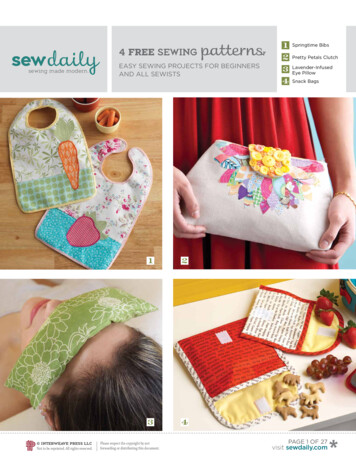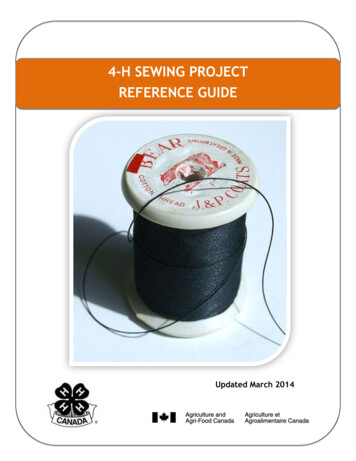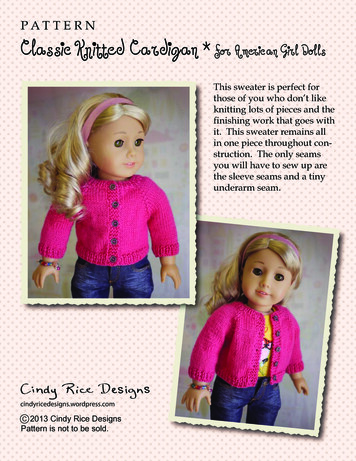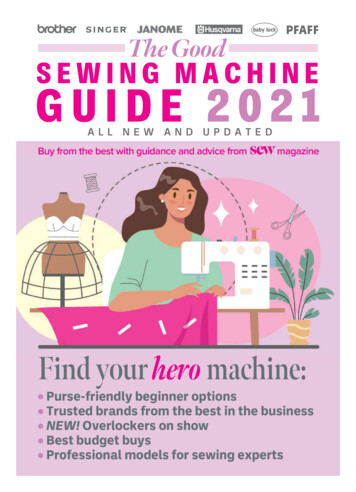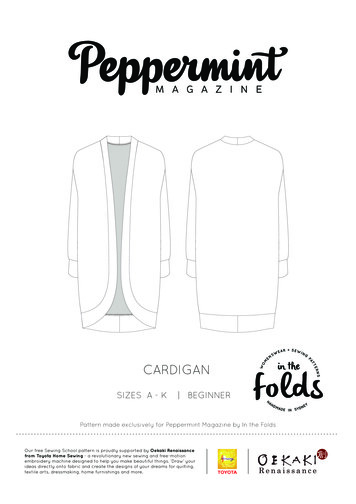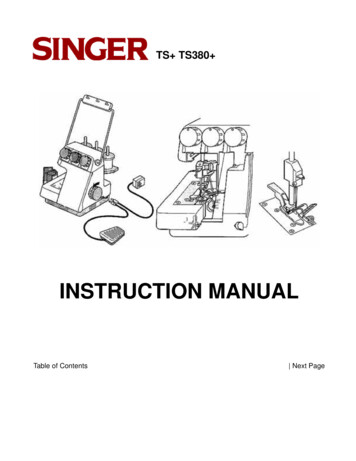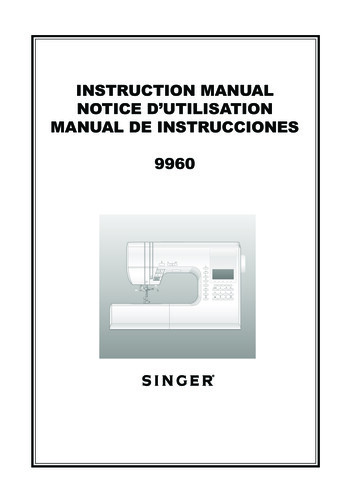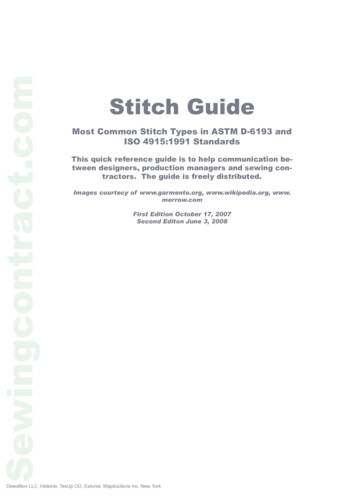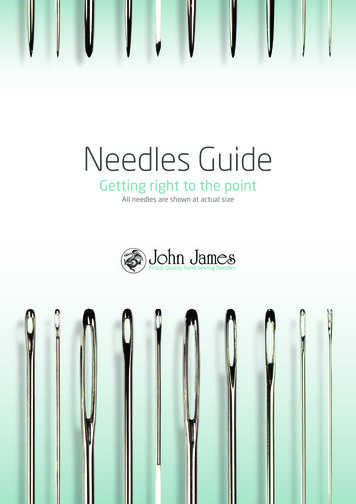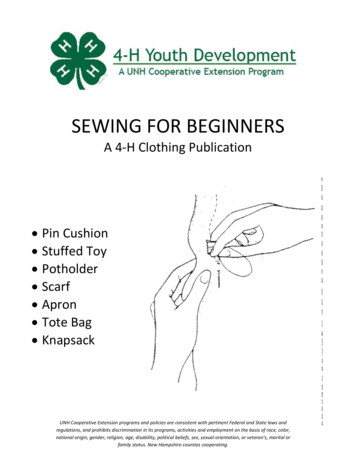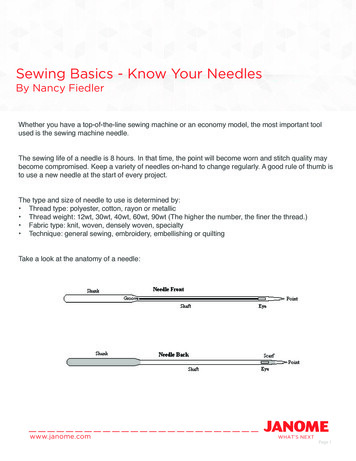
Transcription
Sewing Basics - Know Your NeedlesBy Nancy FiedlerWhether you have a top-of-the-line sewing machine or an economy model, the most important toolused is the sewing machine needle.The sewing life of a needle is 8 hours. In that time, the point will become worn and stitch quality maybecome compromised. Keep a variety of needles on-hand to change regularly. A good rule of thumb isto use a new needle at the start of every project.The type and size of needle to use is determined by: Thread type: polyester, cotton, rayon or metallic Thread weight: 12wt, 30wt, 40wt, 60wt, 90wt (The higher the number, the finer the thread.) Fabric type: knit, woven, densely woven, specialty Technique: general sewing, embroidery, embellishing or quiltingTake a look at the anatomy of a needle:www.janome.comPage 1
Sewing Basics - Know Your NeedlesA sewing machine needle is made of six parts:1. The Shank is the upper portion of the needle, which is inserted into the sewing machine. Theshank on a needle for domestic sewing has a flat back. This needle system is indicated onsome packaging by these notations: HA x 1, 15 x 1 or 130/705.2. The Shaft is the entire lower portion of the needle. The size of the needle is determined bythe diameter of the shaft. The smaller the number, the smaller the shaft will be. The eye willincrease in size proportionately to the size of the shaft.3. The Groove is on the front of the needle. The Groove is designed to allow the thread to lietightly against the needle as it passes through the fabric.4. The thread passes from the front to the back of the needle through the Eye. The thread needsto flow freely through the eye.5. The Scarf is an indentation on the back of the needle that allows the hook to pass closelyto the needle to form the stitch. The size of the needle will affect the distance of the scarf inrelation to the hook.6. The Point penetrates the fabric and allows the needle to deliver the thread to the hook to formthe stitch. The shape of the point is designed to penetrate different types of fabric.www.janome.comPage 2
Sewing Basics - Know Your NeedlesChoose the needle point for the type of fabric. Ball Point 15 x 1 - has a rounded tip that goes between the fibers of the fabric rather thancutting them. Use of a ballpoint needle is recommended on cotton knit, tricot, jersey knits andswimwear fabrics. Denim/Jeans Needle 15 x 1 - has a special wedge shaped tip to produce optimum resultswhen sewing through multiple layers of dense thick fibers like denim and canvas.www.janome.comPage 3
Sewing Basics - Know Your Needles Leather Needle 15 x 1 - has a lens shaped point for cutting through leather and man-madeleather type fabrics. A longer stitch length is recommended so there is extra distance betweenthe holes created by the needle. Top Stitch Needle 15 x 1 - has an extra-long eye to accommodate heavy and specialtythreads.www.janome.comPage 4
Sewing Basics - Know Your Needles Universal Needle 15 x 1 - is for general sewing of most woven and knit fabrics. The tip isslightly rounder than a sharp, but not as round as a ball point. Sharp Needle 15 x 1 - is designed with an extra fine point to pierce densely woven fabricssuch as microfiber or thin smooth fabric like taffeta or coated fabrics.Among the needle types are specialty needles which offer the user features for specificapplications. Janome Blue Tip - is a size 11 ball point needle specially designed for Janome machines. Theneedle works well on light-medium weight knit fabrics and is the recommended needle for lightto medium weight embroidery. Also it works well when quilting with polyester thread.www.janome.comPage 5
Sewing Basics - Know Your Needles Janome Purple Tip - is a size 14 ball point needle specially designed for Janomemachines. This needle is best for heavy weight knits and dense embroidery designs. It is therecommended needle for quilting with cotton threads. Janome Red Tip - is a size 14 sharp point, which is good for general sewing of mediumweight fabrics. Titanium Needles - have a titanium coating which increases the life of the needle. Theseneedles can be used for about 40 hours.www.janome.comPage 6
Sewing Basics - Know Your NeedlesNeedle types come in an assortment of size, choose the needle size for the weight of fabricand weight of thread. Use the chart below as a guide.Needle Sizes:*Keep an assortment of needles on hand to make it easy to choose the appropriate needle foreach project.Troubleshooting: If the thread is breaking or shredding, go up one needle size or try a Top Stitch needle. If the stitches are skipping, change the type of needle point, i.e. Ball Point or Sharp. If the thread is bouncing, go down one size. Check the needle plate, bobbin case and hook often. Any small imperfections may snag thethread as it passes and cause breakage. Clean the machine often.www.janome.comPage 7
Sewing Basics - Know Your Needles By Nancy Fiedler Whether you have a top-of-the-line sewing machine or an economy model, the most important tool used is the sewing machine needle. The sewing life of a needle is 8 hours. In that time, the point wi
